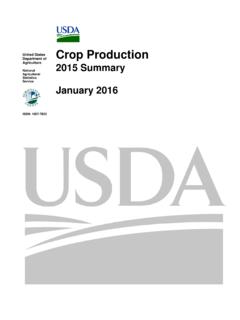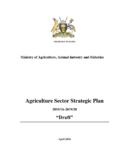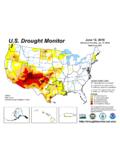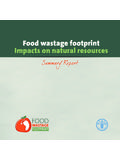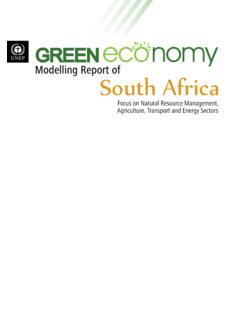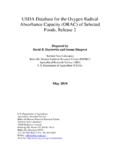Transcription of Pig Sector Kenya - Food and Agriculture Organization
1 Dairy SectorDairy SectorPoultry SectorLivestock Country ReviewsFAO ANIMAL PRODUCTION AND HEALTH livestock country reviewsFAO ANIMAL PRODUCTION AND HEALTHPig SectorPig Sector3 PIG SECTORK enya3livestock country reviewsFOOD AND Agriculture Organization OF THE united NATIONSRome, 2012 FAO ANIMAL PRODUCTION AND HEALTHPIG SECTORK enyaRecommended CitationFAO. 2012. Pig Sector Kenya . FAO Animal Production and Health Livestock Country Reviews. No. 3. detailsSamuel Maina Githigia is a senior lecturer at the Faculty of Veterinary Medicine of the University of Nairobi and a member of a research group from the Government ministries, Kenya Agricultural Research Institute and University of Nairobi that is mapping the pork value chain in Kenya .
2 He has interest in poverty alleviation among small-holder farmers through improving livestock health and production, having extensive research experience on the effects of parasitic infestations on these livestock systems in Okuthe is a consultant epidemiologist based at the FAO Emergency Center for Transboundary Animal Diseases (ECTAD) of Eastern Africa in Nairobi, Kenya . His work involves capacity building in epidemio-surveillance, risk analysis, one health, emergency preparedness in reference to Transboundary Animal Diseases (TADs) and general management of TADs in the eastern Africa region working very closely with the national governments through the Department of Veterinary Services.
3 Bouna Diop is the Regional Manager of the FAO Emergency Center for Transboundary Animal Diseases (ECTAD) of Eastern Africa in Nairobi, Kenya . He is working within the EMPRES group, providing technical assistance to Eastern African countries on the design and implementation of programs and projects, formulation of relevant response strategies to TADs, promoting and fostering regional networks (epidemiology, laboratories and socio-economic).The designations employed and the presentation of material in this information product do not imply the expression of any opinion whatsoever on the part of the Food and Agriculture Organization of the united Nations (FAO) concerning the legal or development status of any country, territory, city or area or of its authorities, or concerning the delimitation of its frontiers or boundaries.
4 The mention of specific companies or products of manufacturers, whether or not these have been patented, does not imply that these have been endorsed or recommended by FAO in preference to others of a similar nature that are not views expressed in this information product are those of the author(s) and do not necessarily reflect the views of 978-92-5-107127-4 (PDF) All rights reserved. FAO encourages reproduction and dissemination of material in this information product. Non-commercial uses will be authorized free of charge, upon request. Reproduction for resale or other commercial purposes, including educational purposes, may incur fees. Applications for permission to reproduce or disseminate FAO copyright materials, and all queries concerning rights and licences, should be addressed by e-mail to or to the Chief, Publishing Policy and Support Branch, Office of Knowledge Exchange, Research and Extension, FAO, Viale delle Terme di Caracalla, 00153 Rome, Italy.
5 FAO 2012 i Foreword Pig production is, along with poultry production, the fastest growing livestock Sector worldwide and this trend is expected to continue over the coming years. Growth in the Sector is mostly happening in developing and in-transition countries while animal numbers in developed countries are stable or declining slightly. Pig production is gaining importance in societies that are currently undergoing a shift from ruminant to monogastric livestock production. Increasing demand, a shorter life cycle with higher return rates and advantageous feed efficiency are key reasons for this development.
6 The role pig-keeping might play for the farmer, especially when referring to small-scale and backyard farming systems, goes far beyond pork production and income generation. Pigs are, from an economic perspective, an asset representing a store of wealth or safety net for times of crisis; while, from a sociological perspective, traditional ceremonies and beliefs in some places centre on the pig as an asset crucial to their belief system. With regard to gender, pigs are the key income generator for women, or marginalized groups within society, in some cultures. The expanding pig production Sector is facing diverse challenges.
7 Sustainable Sector growth implies an accompanying growth in infrastructure which, in many countries, is not happening at the same pace. This discrepancy, combined with the Sector s growing importance in the livelihoods of more and more people, makes it a vulnerable component of the economic and social backbone of a number of countries. Insecure feed availability, insufficient sanitation and poor pig husbandry, as well as a lack of sound veterinary services and meat inspection are factors that lead to poor animal, public, and environmental health. In order to develop appropriate strategies for Sector development, including disease control measures, a better understanding is required of the different pig sectors, their associated market chains, and the position of pigs within society.
8 This review for Kenya have been developed in collaboration with FAO ECTAD, Eastern Africa and is part of a series of Country Reviews commissioned by the Animal Production and Health Division (AGA). It is intended as a resource document for those seeking information about the pig Sector at a national level, and is not exhaustive. Some topics are only partially covered or not covered at all and this document is subject to ongoing updating. The author(s) and FAO/AGA welcome your contributions and feedback. ii Contents Foreword .. i Contents .. ii Acronyms and abbreviations .. iv The country in 1 Profile of the pig 3 LIVESTOCK DISTRIBUTION IN Kenya .
9 3 GEOGRAPHICAL DISTRIBUTION OF THE PIG POPULATION .. 3 PRODUCTION .. 4 CONSUMPTION .. 5 TRADE .. 6 PRICES .. 7 Pig production systems .. 9 BACKGROUND INFORMATION .. 9 History .. 9 Present-day .. 9 INDUSTRIAL / INTEGRATED PRODUCTION .. 10 Breeding stock / Piglet production .. 10 Fattening .. 10 INTERMEDIATE (COMMERCIAL) SYSTEMS .. 11 Breeding stocks / Piglet production .. 11 Fattening .. 11 SCAVENGING OR BACKYARD PRODUCTION .. 12 CASE STUDIES .. 13 Case study one .. 13 Case study two .. 13 Case study three .. 14 PIG FEEDS .. 15 Local feed resources .. 15 Imported feed resources .. 15 Use of crop residues / by-products.
10 15 Feed baskets .. 17 Trade, marketing and markets .. 19 DOMESTIC MARKET .. 19 Animal trade markets .. 19 Slaughtering facilities .. 19 Value chains .. 22 Main trade routes .. 26 iii IMPORT .. 26 EXPORT .. 27 Socio-economic indicators .. 29 CULTURAL BACKGROUND INCL. TRADITIONS AND RELIGION .. 29 TIME ALLOCATION .. 29 CONTRIBUTION TO HOUSEHOLD INCOME / FAMILY ECONOMICS .. 30 GENDER ASPECTS .. 30 Breeds .. 31 EXOTIC BREEDS .. 31 LOCAL BREEDS .. 32 Wildlife .. 33 WILDLIFE POPULATION (SUIDAE / TAYASSUIDAE) .. 33 HUNTING / CONSUMPTION .. 33 INTERACTION WITH DOMESTIC PIGS .. 33 Animal, public and environmental health .. 35 MAJOR PIG DISEASES REPORTED / PRESENT.










